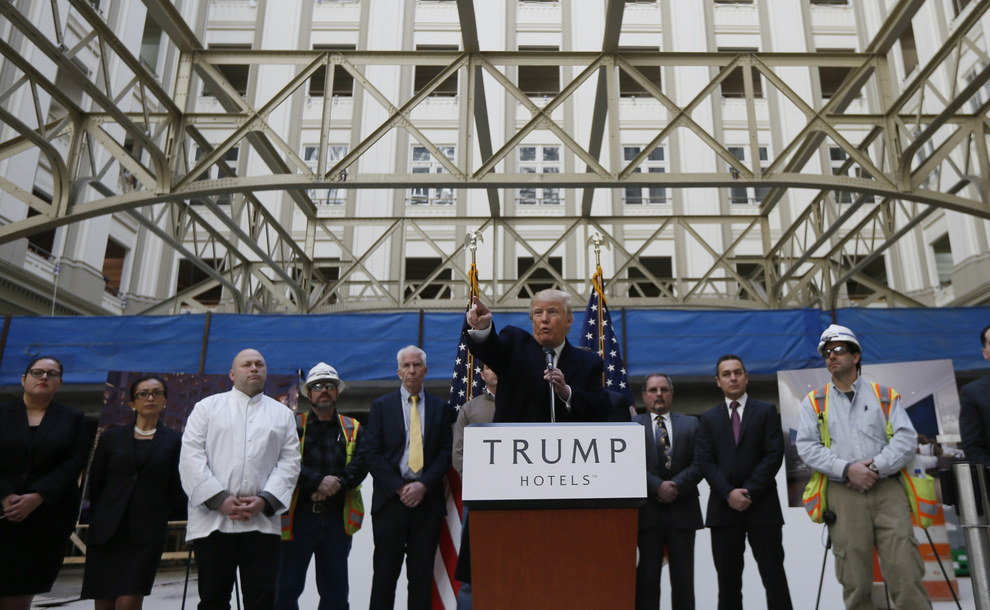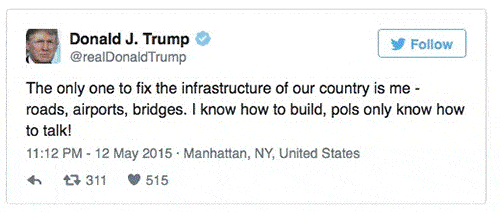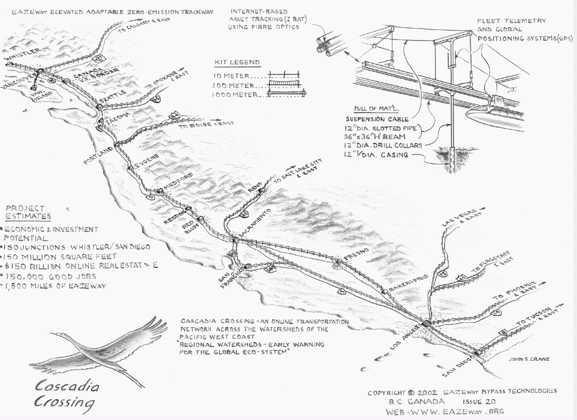United States Marine Field McConnell
Plum City Online - (AbelDanger.net)
January 19, 2017
Abel Danger (AD) has explained how President Donald Trump's cabinet can build a resilient CyberFix" system for leaders of the states, federal government and regional communities by sponsoring a cyber-hack-resistant EAZEway monorail network (see below) with core technologies designed by AD's forensic economists for an initial pilot on Route 66.
AD claims that the reason why America's infrastructure is so vulnerable to cyber hacks during terrorist attacks and natural disasters is that the Clinton administration (1993-2001) used the Federal Bridge Certification Authority to outsource U.S. resilience training and exercising to the highly-compromised racketeer-influenced British company Serco.
AD claims that Serco is using the U.K. offender tagging program and the U.S. Justice Prisoner and Alien Transportation System (JPATS – a.k.a."Con Air") to transfer felons including saboteurs and assassins between prisons for deployment on release or parole on 8(a) cyberhack missions based out of elite hotels.
AD claims that on 9/11, Serco equipped pay-to-play donors to the Clinton Foundation with access to the Federal Bridge Certification Authority to coordinate cyber attacks on assets in the custody of 8(a) mentors such as Boeing, Lockheed Martin, Northrop Grumman and Raytheon from their hotel rooms.
AD claims that Serco shareholders used the Office of SBIC Liquidation with BNY Mellon as trustee and Goldman Sachs, Credit Suisse and JPMorgan as underwriters to finance the London Underground attacks where Serco allegedly set up a Resilience Center in the Honourable Artillery Company grounds to bypass autopsies on the victims' bodies and avoid exposing 8(a) cyber detonation of military explosives on 7/7.
AD alleges that Serco hacked Deepwater Horizon drilling rig communications on April 20, 2010 and ordered the Schlumberger cement-bond logging crew to leave on an 11:15 am helicopter flight without recording the log thereby allowing the blowout to proceed and support a $20 billion fine of BP by the United States Department of Justice.
AD claims that Canada could serve as a role model for pioneering resilience projects having built a series of five-star grand hotels across the country in the 19th century in a joint venture with railway companies where the railways and their passengers acted as a catalyst for the hotel construction.
United States Marine Field McConnell – Global Operations Director of Abel Danger – is now asking to meet with President-elect Trump and his pick for Commerce Secretary Wilbur Ross to discuss how to shut down Serco's allegedly-bogus resilience training programs and substitute a pilot "smart grid" combining hotels, businesses and the cyber-hack resilient EAZEway monorail along Route 66.
(Get Your Kicks On) Route 66
Serco Combined Resilience
Peter Power 7/7 Terror Rehearsal
SERCO Owns the World, | Big Brother Watch
Copy of SERCO GROUP PLC: List of Subsidiaries AND Shareholders!
(Mobile Playback Version)
"Digital Fires [Cyber Hack] Instructor Serco – Camp Pendleton, CA Uses information derived from all military disciplines (e.g., aviation, ground combat, command and control, combat service support, intelligence, and opposing forces) to determine changes in enemy capabilities, vulnerabilities, and probable courses of action."
"Is Trump's $1 Trillion Privately Funded Infrastructure Plan Feasible?
by Tyler Durden Nov 12, 2016 12:39 PM
President-elect Trump has made a $1 trillion infrastructure investment one of his first priorities as president, promising in his victory speech early Wednesday morning to “rebuild our highways, bridges, tunnels, airports, schools, hospitals." As Goldman's economics research team points out, Trump's plan, as detailed in a report released by his economic advisers Wilbur Ross and Peter Navarro, calls for $1 trillion of spending over 10 years to be funded largely by private sources which would be repaid with tax credits and usage taxes (i.e. toll roads)."
"EAZEway* Vision: (*Elevated Adaptable Zero-Emission Trackway) http://eazeway.org/Vision.html
EAZEway monorail: An Elevated Adaptable Zero-Emission Trackway with a low cost, slim, elegant "plug-and-play" monorail suspended between low-profile drill collars which is adaptable, removable, quick build and very affordable for all applications over urban/suburban community or even hostile terrain:
• Bypasses traffic corridor congestion
• Low cost to build and operate enabling wide area regional transit;
• Proven technologies reconfigured from aerospace, military & oil-field industries;
• Rapid deployment over all terrain (land and water)
• Environmentally friendly with low-impact construction and operation;
• Public Security protection against acts of nature or sabotage;
• No-Tax Burden via Community Income Trusts;
The "plug-and-play" EAZEway monorail provides to regional communities anywhere in the world with a potentially self-funding and revenue generating, transportation, communication, real-estate network.
Some benefits of the EAZEway system are: very low cost or free public transit, revenues to the community, new local jobs, environmentally sound (during construction and operation), new real-estate infrastructure, citizen access to online data of all the resources in transit and local environmental data tracked by the network.
Design of the routes, buildings and joint venture agreement are created with the participation of citizens, including community referenda. Community ownership and input to initial designs of major projects is a key to the success of any viable venture.
We have adopted virtual prototyping as a proven method of reducing the risks associated with major projects. We can then reconfigure existing, proven, safe technologies and business models in novel, evolutionary ways. This enables a much larger, widespread system for moving people and commercial goods.
Greater reach and accessibility to larger areas of a region created by the design and affordability of the EAZEway system enables dramatically increased ridership and reduced automobile traffic. The cost of constructing a transportation network of a large enough coverage to efficiently and profitably service a region has previously be unavailable and has been a major limitation with regional transportation models.
Very low capital cost and very fast construction time frames makes a larger network affordable. This enables, for the first time, the opportunity to build fast, safe, high-speed, mass transit with greatly increased reach into and around more communities in a region. The greatly increased efficiencies of scale, accessibility, convenience and functionality increases ridership on the system. The presently over-reaching and underfunded bus routes can be reconfigured for lower costs and greater efficiency.
Lower ridership links, and environmentally sensitive routes to specialty destinations like Vancouver to Whistler and local islands are now viable because of the low cost and unique methods of construction. The construction methods and footprint of the EAZEway system have a near-zero environmental impact. Operation is also zero-emission with silent vehicles capable of between 300-400 km/h estimated top speeds. The landscape on EAZEway routes can enhanced by the attractive structural design and gives the opportunity to remove many types of lamp posts, poles, overhead wires-cape etc. and incorporate them seamlessly into the EAZEway structures.
The Real-Estate Income Trust turns what traditionally is a tax burden, transit, into a revenue generating asset adding additional value to the community. The reach and coverage of the EAZEway network combined with existing transit systems creates enough rider-ship to justify commercial real-estate "on the line" in "hub-buildings" and smaller stations. By combining the high volume rider-ship and more convenient access to the hubs, the tenants and investors of the buildings enjoy highly valued locations.
The Segregated Easement Income Trust is now viable due to the reach and coverage of the EAZEway network. Again, this makes the traditional tax burden, transit, into a revenue source for communities. Easement income created by leasing space on the support structures to fibre-optics, power, water, cellular and other commercial service industries. The revenue generated by easements helps fund the operation of the EAZEway network and also creates revenues for the communities that grant easements to the network. The network can move freight, day and night.
The combination of low cost to build and operate with revenue generating real-estate and easements enables the EAZEway system to be a free public transit system accessible to a much greater number of people and generating multiple benefits to a region.
The EAZEway network, business enterprise models, and I-BAT systems are key initiatives of EAZEway Bypass Technologies (EBT) for the empowerment and development of regional communities and their citizens. For a light-hearted, illustrative introduction to the EAZEway - an overhead bypass solution to congested transportation, energy and communications corridors."
"These Are The Top 10 US Infrastructure Projects Trump Will Focus On
by Tyler Durden
Jan 18, 2017 6:20 PM
With Trump's Commerce Secretary, Wilber Ross, currently speaking in his confirmation hearing, it is convenient that overnight Barclays released a report looking at steel demand in the US as a result of Trump's proposed stimulus projects, an area that will be of substantial focus by Ross as he seeks to revitalize the moribund US steel sector.
That said, Barclays notes that while the potential demand from US infrastructure is there, it notes that it is skeptical on implementation for two main reasons. One is the rising risk of protectionism:
We think that hopes for a large infrastructure boost are premature, and the risks from potentially increased US protectionism are a significant headwind to higher global consumption. The potential for a large rise in commodity demand is certainly there, but we think that the market is "trumping up" the likely effects of Trump’s policies, as additional infrastructure spending requires rapid execution to yield the full metals’ demand boost.
Second is the still overarching lack of clarity about Trump's plan:
Given the unknowns about Trump's infrastructure plan – lack of clarity on total spend, past ineffectiveness of stimulus efforts, timing of implementation, pushback from Congress – we currently model no additional metals demand from supplemental infrastructure investment during 2017-18 into our baseline forecast. As greater visibility becomes available, we will adjust our consumption forecasts to take into account the latest spending plans. The key issue we think is facing the metals sector is that even if infrastructure spending is approved at the headline level ($1trn over 10 years, or $100bn a year) and implementation is effective, the project schedule does not allow for an immediate effect on metals consumption, particularly over the next two to three years.
And while Trump's plans may or may not materialize as rapidly as home hope - or may be hindered entirely due to the rise of protectionism - Barclays has compiled this handy list of the top 10 infrastructure projects currently under planning or development in the US. As it notes, of the top 10, 7 are in the planning or conceptual phase. According to Cg-LA, an infrastructure consulting firm, and the average time to complete an infrastructure project currently stands at 9.5 years, meaning that many of the identified projects will not be completed during 2017-18.
The projects have a combined cost of $132.6 billion, and have the potential to materially boost demand for both copper and steel, not to mention create tens of thousands of jobs.
As for the final, and rhetorical, question - whether California really needs a high-speed rail system at a cost of $68 billion - it remains open for debate."
"The Combined Resilience Exercising capability is built upon the strong foundation of Gold Standard, developed by the UK Cabinet Office with extensive input from practitioners within the UK resilience community. It is flexible and adaptable in approach and scalable across different levels of authority and management. The intensity and complexity can be adjusted to suit the training audience as can the range of technical simulation support. This capability is underpinned with a deep knowledge pool of highly qualified and experienced Subject Matter Experts that cover all key sectors, local government, international and commercial, and the rigour and best practice of the UK Cabinet Office."
"Canada's railway hotels are a series of five-star grand hotels across the country, each a local and national landmark, and most of which are icons of Canadian history and architecture. Each hotel was originally built by the Canadian railway companies, or the railways acted as a catalyst for the hotel's construction. The hotels were designed to serve the passengers of the country's then expanding rail network and they celebrated rail travel in style."
Yours sincerely,
Field McConnell, United States Naval Academy, 1971; Forensic Economist; 30 year airline and 22 year military pilot; 23,000 hours of safety; Tel: 715 307 8222
David Hawkins Tel: 604 542-0891 Forensic Economist; former leader of oil-well blow-out teams; now sponsors Grand Juries in CSI Crime and Safety Investion






No comments:
Post a Comment
Note: Only a member of this blog may post a comment.